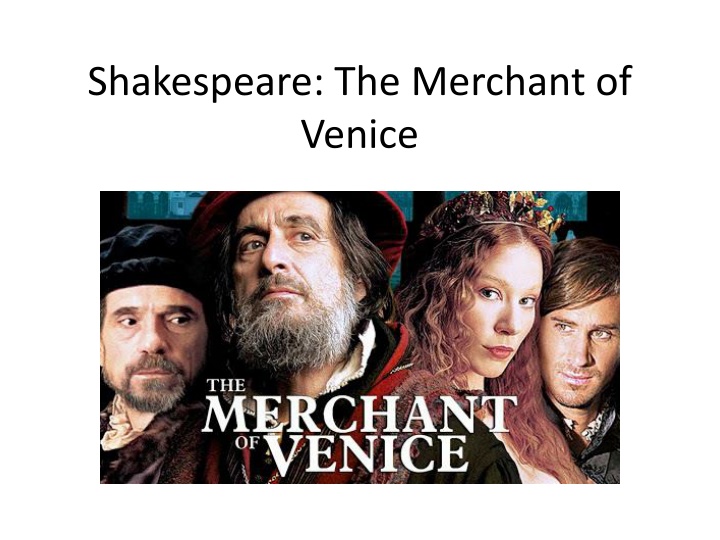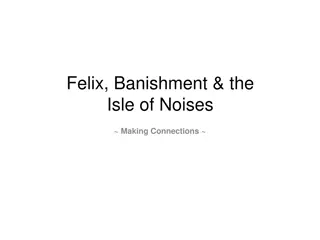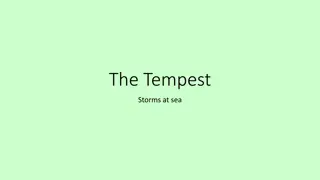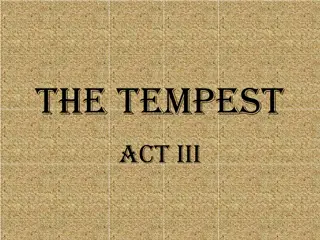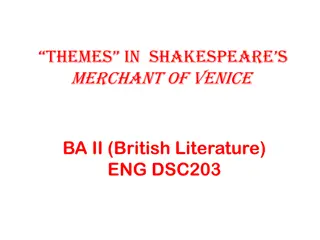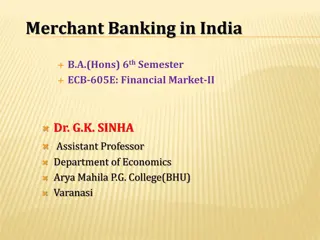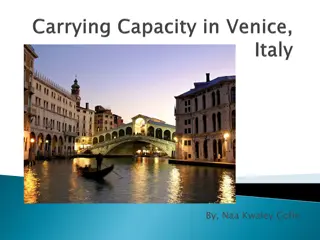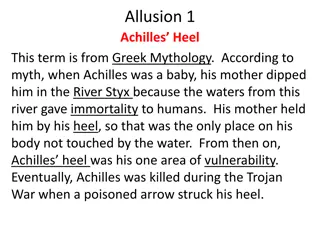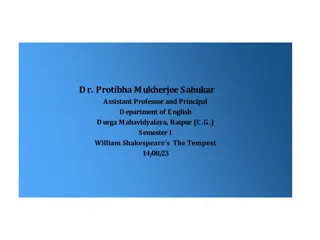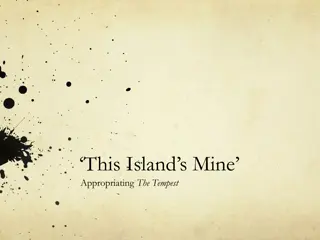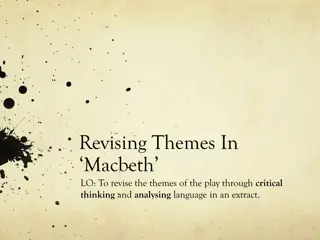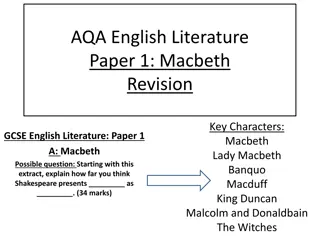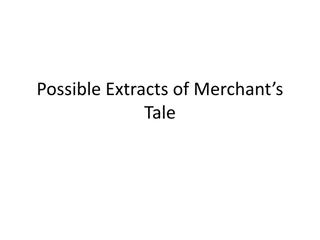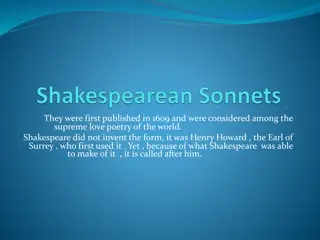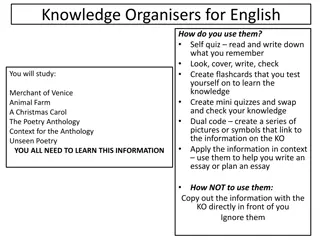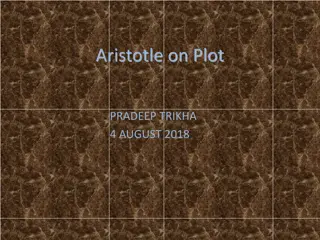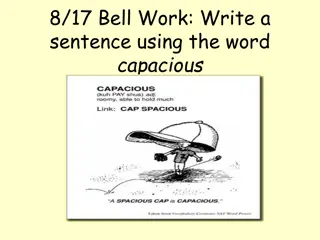Plot and Themes of "The Merchant of Venice" and "The Tempest" by Shakespeare
The plots of "The Merchant of Venice" and "The Tempest" by Shakespeare involve complex relationships and themes. In the former, the story revolves around Bassanio's quest for money to marry Portia, leading to a dramatic court case with the moneylender Shylock. The theme of anti-Semitism is prominent in the play, challenging societal prejudices. Meanwhile, "The Tempest" follows Duke Prospero's journey of revenge and redemption on a magical island. Themes of power, illusion, and forgiveness are central to the storylines of both plays.
Download Presentation

Please find below an Image/Link to download the presentation.
The content on the website is provided AS IS for your information and personal use only. It may not be sold, licensed, or shared on other websites without obtaining consent from the author.If you encounter any issues during the download, it is possible that the publisher has removed the file from their server.
You are allowed to download the files provided on this website for personal or commercial use, subject to the condition that they are used lawfully. All files are the property of their respective owners.
The content on the website is provided AS IS for your information and personal use only. It may not be sold, licensed, or shared on other websites without obtaining consent from the author.
E N D
Presentation Transcript
Shakespeare: The Merchant of Venice
The plot (1) Bassanio needs money to woo and marry the rich Portia. He asks his friend Antonio, the Merchant of Venice, but he has no money because his ships are at sea. Bassanio then asks moneylender, Shylock, and Antonio will be the guarantor. Antonio offends Shylock for being a Jew and Shylock says that if the debt is not paid on time, Antonio must give him a pound of his flesh. money to a Jewish
The plot (2) Antonio s ships are lost at sea and he can t pay the debt. He is arrested and Shylock wants his flesh. In the meantime, Bassanio has conquered and married Portia. When he hears that Antonio is in danger, Portia disguises as a lawyer and go to Venice. As a lawyer, in court Portia says that Shylock can have the flesh, but on the contract there is no mention of blood. So Shylock must not spill blood while obtaining Antonio s flesh.
The plot (3) Shylock accepts the defeat but wants money. Portia says there is a law that says that any alien who plots against a Venetian s life will lose his life and property. The judge spares Shylock but orders him to give half his property to Antonio. The other half goes to his daughter Jessica, who marries Lorenzo. Shylock also has to become Christian. Antonio hears his ships have come back and they are all happy.
The theme: Anti-Semitism At Shakespeare s time, the society was against the Jew. In Venice they built the first ghetto and Jews had to wear a red hat. But at that time there were no Jews in England. However, the figure of Shylock is not completely negative and the Christian characters are not completely positive: the most moving speeches are given by Shylock; The people who accused Shylock of dishonesty, turn the case against him using dishonest means.
Other themes So maybe, the plot is AGAINST PREJUDICE and a CALL FOR TOLERANCE. Other important themes are: 1) The victory of love over greed Shylock represents greed: when his daughter marries Lorenzo, he is more worried about the property he loses; 2) friendship, as between Antonio & Bassanio: Antonio is ready to give his flesh for Bassanio 3) Revenge.
The plot (1) Prospero was the Duke of Milan, but his brother Antonio deposed him from the throne. Prospero is shipwrecked with his daughter Miranda on an island. The only inhabitant of the island was a monster, Caliban. Thanks to his magic, Prospero frees a spirit, called Ariel, who had been imprisoned by the witch Sycorax. Sycorax and Caliban become his servants.
The plot (2) Thanks to his magic, one day, Prospero causes a tempest and the ship where Antonio was with Alonso (king of Naples), his brother Sebastian and Alonso s son Ferdinand is shipwrecked. They are dispersed around the island. Ferdinand meets Miranda and they fall in love, but Prospero puts a spell on Ferdinand to protect Miranda.
The plot (3) In the meantime, Antonio and Sebastian want to kill Alonso. Caliban wants to kill Prospero and take control of the island again. With the help of the spirit Ariel, all the characters are reunited: - Antonio gives Milan back to Prospero, and - Prospero frees Caliban and Ariel.
The themes MAGIC is the main theme. There are 2 types of magic: 1) Sycorax s (black magic) and 2) Ariel s (white magic). Prospero is a good magician and uses it for good purposes. For example, he uses it to protect Miranda s chastity. This remind the emblem of Queen Elizabeth s chastity.
Power and Colonialism Prospero and Caliban represent the power of colonisers over colonised people. Prospero calls Caliban a devil, a born devil . Prospero and Miranda teach Caliban their language and to become a servant. This refers to the colonisation of America and the idea of imposing European values on the natives, who were considered savages. Prospero s release of Caliban at the end, however, indicates that he shares with him his savage and uncontrollable nature.
